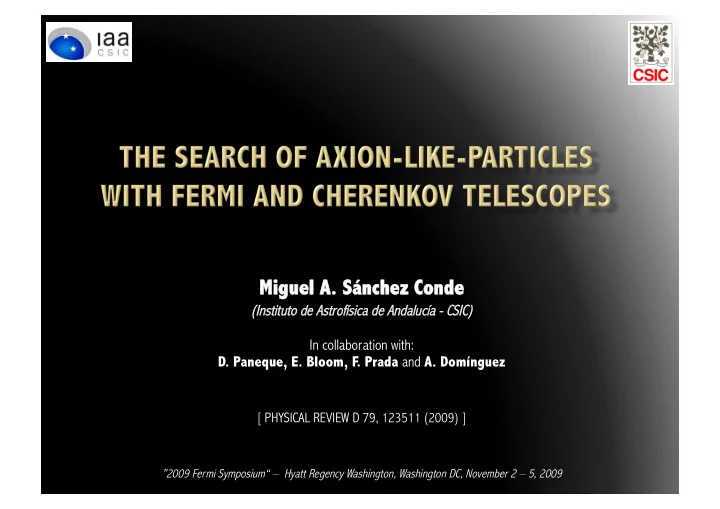

Miguel A. Miguel A. Sánchez ánchez Conde Conde (Instituto Instituto de de Astr strofísica ofísica de A de Andalucía - CSIC) ndalucía - CSIC) In collaboration with: D. Paneque, E. Bloom, F. Prada and A. Domínguez [ PHYSICAL REVIEW D 79, 123511 (2009) ] ”2009 Fermi Symposium“ – Hyatt Regency Washington, Washington DC, November 2 – 5, 2009
Axions were postulated to solve the strong CP problem in the 70s. Good Dark Matter candidates (axions with masses ≈ meV- µ eV could account for the total Dark Matter content). They are expected to oscillate into photons (and viceversa) in the presence of magnetic fields: � B ¼ B t P 0 ¼ ð � B s Þ 2 sin 2 ð � osc s= 2 Þ 2 M ’ 1 : 7 � 10 � 21 M 11 B mG cm � 1 ; ð � osc s= 2 Þ 2 : with osc ’ ð � CM þ � pl � � a Þ 2 þ 4 � 2 � 2 B ; Photon/axion oscillations are the main vehicle used at present in axion searches (ADMX, CAST…). M 11 : coupling constant inverse 15 ⋅ B G ⋅ s pc Some astrophysical environments (g αγ /10 11 GeV) ≥ 1 fulfill the mixing requirements M 11 B G : magnetic field (G) AGNs, IGMFs s pc : size region (pc) M 11 11 ≥ 0.114 0.114 GeV GeV ( (CA CAST ST limit limit)
AGNs located at cosmological distances will be affected by both mixing in the source and in the IGMF: m 2 µeV M 11 A. Source mixing: attenuation E crit ( GeV ) ≡ B. IGM mixing: attenuation and/or enhancement 0 . 4 B G In order to observe both effects in the gamma-ray band, we need ultralight axions.
Axion boost =(Flux w axions) / (Flux w/o axions) z=0.536 1000 z=0.117 Axion boost factor Intergalactic mixing Axion boost factor 100 10 1 1 0.1 1.0 10.0 100.0 1000.0 10000.0 E (GeV) 0.1 1.0 10.0 100.0 1000.0 E (GeV) Enhancement due to intergalactic mixing Attenuation due to source mixing Attenuation due to intergalactic mixing Larger axion boosts for distant sources. The more attenuating the EBL, the larger the axion boosts.
IACTs observations Look for systematic intensity enhancements at energies where the enhancements 1000 EBL is important. Axion boost factor Distant (z > 0.2) Distant ( > 0.2) sour sources ces at the 100 highest possible energies (>1 TeV), to push EBL models to the extreme. 10 Sour Source and E ce and EBL model de BL model dependent, pendent, but very important enhancement expected in some cases. 1 0.1 1.0 10.0 100.0 1000.0 E (GeV) Fermi/LAT and/or IACTs Fermi/LAT and/or IACTs Look for intensity dr drops ops in the residuals (“best- Look for intensity dr drops ops in the residuals. model”-data). Only depends on the IGMF and axion properties (mass and Sour Source model de ce model dependent. pendent. coupling constant). Powerful, relatively near near AGNs. Independent of Independent of the sour the sources ces -> CLEAR signa -> CLEAR signatur ture! e!
Recent gamma observations might already pose substantial challenges to the conventional models to explain the observed source spectra and/or EBL density. The VERITAS Collaboration recently claimed a detection above 0.1 TeV coming from 3C66A (z=0.444). EBL-corrected spectrum harder than 1.5 (Acciari+09). TeV photons coming from 3C 66A? (Neshpor+98; Stepanyan+02). Difficult to explain with conventional EBL models and physics. The lower limit on the EBL at 3.6 µ m was recently revised upwards by a factor ∼ 2, suggesting a more opaque universe (Levenson+08). Some sources at z = 0.1 - 0.2 seem to have harder intrinsic energy spectra than previously anticipated (Krennrich+08). While it is still possible to explain the above points with conventional physics, the axion/ photon oscillation would naturally explain these puzzles: More high energy photons than expected. Softer intrinsic spectrum when including axions.
Softer intrinsic spectrum with axions We can observe the spectrum up to higher energies with axions (Sánchez-Conde & Dominguez, in prep.) [3C279 data points from the MAGIC Collaboration, Albert et al. 2008]
If axions exist, they could distort the spectra of astrophysical sources importantly. If photon/axion mixing in the IGMFs, then also mixing in the source. For m axion ≈ 10 -10 eV -> gamma ray energy range. Photon/axion mixing in both the source and the IGM are expected to be at work over several decades in energy -> joint effort of Fermi and current IACTs needed. needed. Fermi/LAT instrument expected to play a key role, since it will detect thousands of AGNs (up to z ∼ 5), at energies where the EBL is not important. IACTs specially important at higher energies (>300 GeV), where the EBL is present. Main caveats : the effect of photon/axion oscillations could be attributed to conventional physics in the source and/or propagation of the gamma-rays towards the Earth. However, detailed observations of AGNs at different redshifts and different flaring states could be used to identify the signature of an effective photon/axion mixing.
Recommend
More recommend